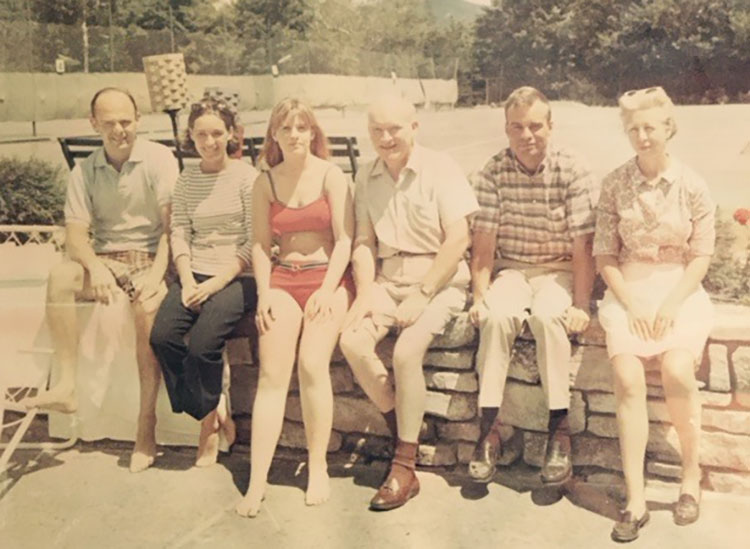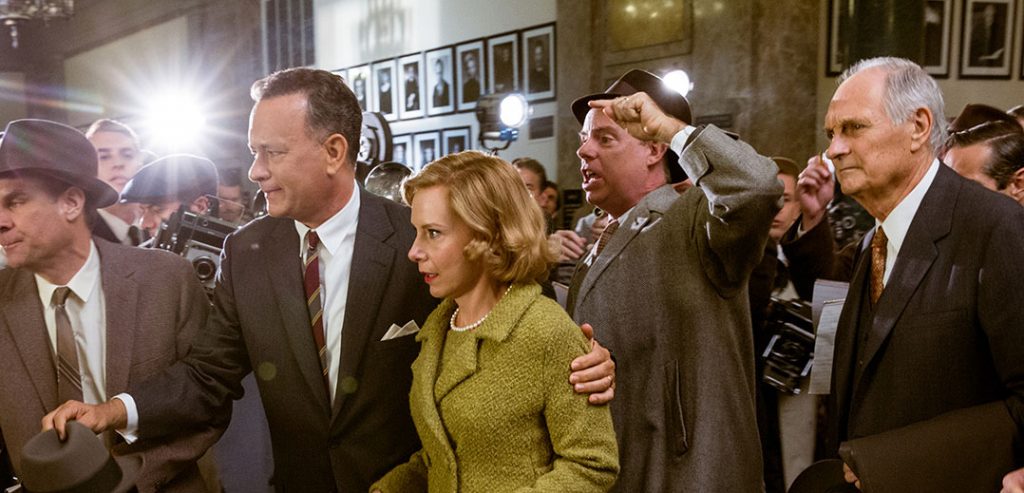Steven Spielberg’s Cold War thriller Bridge of Spies, released nationwide today, stars Tom Hanks as Fordham alumnus James B. Donovan, FCRH ’37, the gritty, principled New York lawyer who pulled off one of the most famous spy swaps in history.
James Britt Donovan once wrote, “The practice of law need not be so dull as young students gloomily prophesy.” His own career—which brought him head-to-head with Nazi war criminals, KGB officers, and Cuban Prime Minister Fidel Castro—was a stunning case in point.The irony is that for much of his professional life, Donovan was engaged in legal work most people would consider mundane. He was a fastidious, high-powered insurance lawyer with bespoke suits and a big gray-carpeted office in Manhattan’s financial district. He worked long hours and traveled often, defending corporate clients throughout the country. But he was also a Brooklyn family man, devoted to his wife and children, and a devout Catholic, who sometimes carried with him a holy card with the Prayer of Saint Francis printed on it.
Early in the film Bridge of Spies, Tom Hanks, playing Donovan, is asked to defend an accused Soviet spy. “I’m an insurance lawyer,” he says, and it’s true. But it’s a vast understatement.
What the film doesn’t make clear is that Donovan was a Navy commander, schooled in spies and spycraft during World War II. He was intimately, selflessly, sometimes secretly involved with what Supreme Court Justice Oliver Wendell Holmes Jr. once called the “passion and action of his times.” A kind of “real-life combination of James Bond and Perry Mason” is how the Chicago Tribune once put it.
In June 1962, his alma mater Fordham put it another way: Upon giving Donovan an honorary degree, the University called him “the most successful American practitioner of metadiplomacy” during the Cold War, someone who could operate above and beyond the usual diplomatic channels to disarm “the world’s best jugglers of words and ideas” and win “a striking victory for his country.”
The success of his diplomatic efforts, however, and the public’s esteem of his work were not always so assured.
South Bronx Cosmopolitan: The “Best All Around Man”
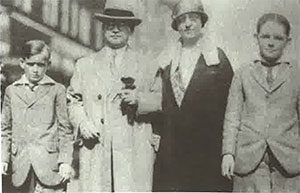
Donovan was born in the Mott Haven section of the Bronx on a leap day, February 29, 1916, the second son of Harriet and Dr. John Donovan.
His mother, a pianist and music teacher, was a Hunter College graduate. His father, a son of Irish immigrants, was a prominent surgeon and, for a time, an assistant professor of operative surgery at Fordham’s medical school. The family brownstone on East 139th Street—not far from Alexander Avenue, then known as the Irish Fifth Avenue—was a hive of activity, where the Donovans instilled in their sons a lifelong commitment to education, faith, and public service.
“They were very forward-thinking people,” said Jan Donovan Amorosi, the eldest of Donovan’s four children. “In the mornings, my grandfather would have office hours at home and use a back room to interview and examine patients. In the afternoons, my grandmother would give music lessons at the grand piano in the living room. And in the evenings they would often host political meetings and rallies.”
The boys attended Catholic grammar and high schools, and in 1933, Donovan—already a voracious reader, with a particular interest in rare books and illuminated manuscripts—followed in his brother’s footsteps, enrolling at Fordham, where he majored in English. In the summer of 1936, the brothers traveled to Europe, where they took in the Olympics in Berlin.
They grew up wealthy—a family chauffeur drove them to school in a Cadillac—but they were at home on the South Bronx streets. An amateur boxer, Donovan had a worn-down knuckle on his right hand and an eyebrow scar he said he got in a “smoker” (an unsanctioned match) at the Good Shepherd Gym.
At Fordham, he played varsity tennis and was editor-in-chief of The Ram. He wrote all of the paper’s editorials as a junior and senior, including a typically forceful, politically conservative October 1936 piece titled “Anti-Christ has Risen,” in which he denounced communism, calling the U.S. Communist Party the “illegitimate child of the Bill of Rights.”
His classmates voted him “Best All Around Man” and the student who’d “Done Most for Fordham.” He considered journalism as a career, but, at his father’s urging, went to Harvard Law instead. He graduated in 1940, by which time he’d fallen in love with Mary McKenna, MC ’40, a Brooklyn girl and Marymount College alumna he’d met in Lake Placid, New York, where their families vacationed. They were married in June 1941.
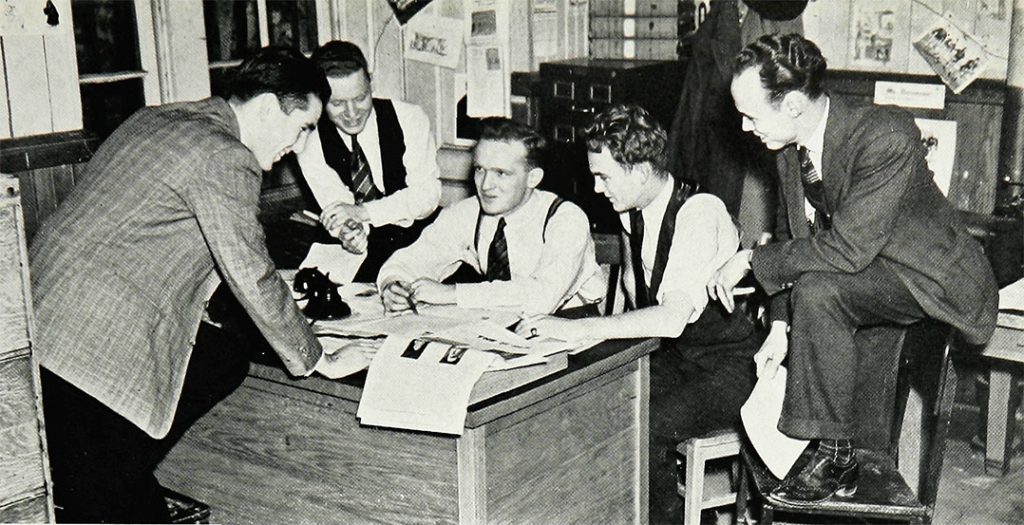
A Nazi War Crimes Prosecutor at Nuremberg: Handling the “Biggest Motion Picture Job in the World”
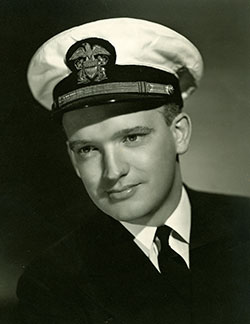
After law school, Donovan handled insurance and libel cases for a New York firm, but within two years, the country was at war. He and Mary moved to Washington, D.C., where he became assistant general counsel in the Office of Scientific Research and Development—the federal agency responsible for developing the atomic bomb.
In 1943, after receiving a commission as an ensign in the U.S. Naval Reserve, he was assigned to the newly created Office of Strategic Services (OSS)—America’s first intelligence agency. Within a year he rose to general counsel and, as the war neared an end in Europe, OSS head Maj. Gen. William “Wild Bill” Donovan (no relation) asked him to lead the spy agency’s war crimes division.
Donovan assigned OSS units to film German concentration camps as they were liberated by allied troops. And he spent much of the summer of 1945 in London, assisting Supreme Court Justice Robert H. Jackson negotiate the treaty that established the International Military Tribunal at Nuremberg, Germany.
Jackson, the chief U.S. prosecutor at Nuremberg, took a shine to Donovan. He recommended him for a spot promotion to full commander, and Donovan served as an assistant prosecutor at the principal Nuremberg trial. He was responsible for presenting all visual evidence of Nazi crimes.
In November 1945, just before the start of the trial, a New York Daily News reporter described Donovan, still in his late 20s, as “a young man with tired eyes” who was “in charge of the biggest motion picture job in the world.” From Nuremberg, he wrote to his wife, Mary: “I haven’t put in any films yet but expect to next week. When I do I feel sure that you will hear about it because my evidence is really the most significant in the case.”
He was referring primarily to two films: The Nazi Plan, which used captured German newsreel and propaganda footage as evidence against the accused war criminals, and Nazi Concentration Camps, which documented the atrocities of the Holocaust in moving pictures as deeply harrowing as they were damning. Donovan provided legal supervision during the production of the films, working with Hollywood directors and other industry pros—including Ray Kellogg, George Stevens, and Budd Schulberg—who were then serving in the OSS. It was his first brush with Hollywood.
In his opening statement at the trial, Jackson said: “Our proof will be disgusting to you and you will say that I robbed you of your sleep.”
Defending a Soviet Spy—and the Constitution: The Case of Colonel Abel
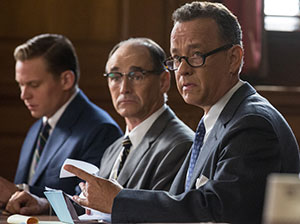
After completing his work at Nuremberg, Donovan rejoined his family, arriving in Brooklyn on Christmas Day 1945. He was discharged from active duty in February and, before long, joined the postwar boom in New York City.
As he became one of the best and busiest insurance lawyers in the country, his brother was a rising political star. In 1950, John Donovan Jr., an assistant U.S. attorney in the Southern District of New York, was elected to a seat in the New York State Senate. He was serving his third term as a state senator in March 1955, when he died suddenly of a heart attack at age 42.
“My father was so extremely sad about his brother,” Jan Donovan Amorosi said. “He stopped on a landing of a house in Brooklyn and just sat there crying when the news came.”
As always, though, Donovan threw himself into his work. Watters & Donovan, the firm he joined as a partner in 1950, was thriving, and by 1957 he and his family had moved into a 15-room duplex apartment on Prospect Park West. On August 19 of that year, the Donovans were at their summer cottage in Lake Placid, unpacking their luggage, when the phone rang.
“It was Ed Gross of our law firm, calling from New York,” Donovan later wrote at the start of his 1964 book, Strangers on a Bridge: The Case of Colonel Abel and Francis Gary Powers. “By the tone of his voice, I could tell he thought he was bearing bad news.”
Gross said, “‘Jim, that Russian spy the FBI just caught. The Bar Association wants you to defend him. What do you think?’”
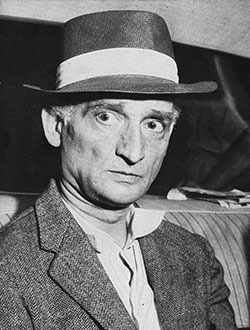
“That Russian spy” was Rudolf Ivanovich Abel, who less than two weeks earlier had been indicted by a Brooklyn grand jury. Donovan had read the newspaper accounts, which, he wrote, “described Abel in a sinister way as a ‘master spy’ heading all illegal Soviet espionage in the United States.”
He discussed the matter with Mary, whose “principal concern,” he wrote, “was that I had been over-working and needed a rest.” The golf pro at the Lake Placid Club was more blunt. “‘Why would anyone want to defend that son of a _____?’ I did my best to explain,” Donovan wrote in an early draft of his book, “but I’m afraid he still thinks my twisted thinking is one of the reasons for my miserable golf swing.”
By 9 p.m., Donovan was on a train back to New York. He’d decided to defend Abel as “a public service,” he later told reporters. In a politic move, he pledged to donate whatever fee he’d receive for his work on the case. (He eventually gave half of his $10,000 fee to Fordham and split the rest between Harvard Law, his alma mater, and Columbia Law, where his assistants earned their degrees.)
As NBC newscaster David Brinkley once noted, in 1957 Donovan “probably had the most unpopular client since John Adams defended the British troops in the Boston Massacre of 1770.” But he was adamant. By “giving Abel an honest defense to the best of my ability,” he wrote in Strangers on a Bridge, “I would be serving my country and my profession.”
American justice, he felt, would also be on trial, just as it was in Nuremberg. In speeches after the war, he often derided a Soviet delegate’s response to the American proposal that accused war criminals should be afforded a fair opportunity to defend themselves. The delegate, Donovan wrote, “utter[ed] a classic if unintended commentary upon police-state justice: ‘We agree; all the guilty should be tried.’”
That sentiment was one shared by many Americans during the 1950s, as postwar fear of communism and communist infiltrators intensified into paranoia. When Abel was indicted, it had been only four years since the United States executed atomic spies Julius and Ethel Rosenberg, and only a few months since the death of Sen. Joseph McCarthy, who’d done perhaps more than anyone to promote the fervid anticommunism of the postwar Red Scare.
After taking the case, Donovan was called a “Commie lover” and received “crackpot letters and phone calls,” some “threatening reprisals if I ‘went too far’ in defending the Russian spy,” he wrote.
Donovan confessed that he sometimes lost his patience and, “more important, my sense of humor,” because the abuse affected his wife and “even the children were forced to take a small dose during the trial.”
His son, John, was 12 years old at the time.
“It was a fascinating time for us all. My sisters and I had implicit trust in our father. There was no doubt that he was doing the right thing,” he said, adding that although Bridge of Spies “took some liberties with the specifics regarding the tension,” picketers did protest outside the family’s apartment building, and “things could’ve gotten scary if we lived in a separate house.”
Donovan kept things light at home when he could. After nearly a month on the case, he finally took a break to enjoy Sunday supper with his family. After the meal, they all gathered at the piano and came up with a song, “Rudolf Ivanovich Abel,” sung to the tune of “Rudolf, the Red-Nosed Reindeer.” In the final verse, they sang: “Now Rudolf’s days are over, / But all other spies agree / Rudolf Ivanovich Abel / will go down in history.”
Months later, Donovan took his son to visit Abel in federal prison, and “we sang our little ditty for him,” Donovan wrote. “He laughed with the understanding of a family man, but rather quickly changed the subject.”
As he worked on the case, Donovan grew to respect Abel, a polymath who spoke six languages and had been in the United States since 1948.
From the beginning, he told reporters that Abel’s case “should be sharply distinguished from that of the Rosenbergs, who were charged with betraying their own country.” Through his work in the OSS, he’d known spies who were mercenaries and spies who were patriots. He put Abel in the latter category, calling him “an intellectual and a gentleman, with a fine sense of humor.”Abel respected his advocate. “The fact that I had a wartime background in espionage,” Donovan wrote, “apparently led Abel to regard me as a sort of retired spy who could appreciate his professional predicament.”
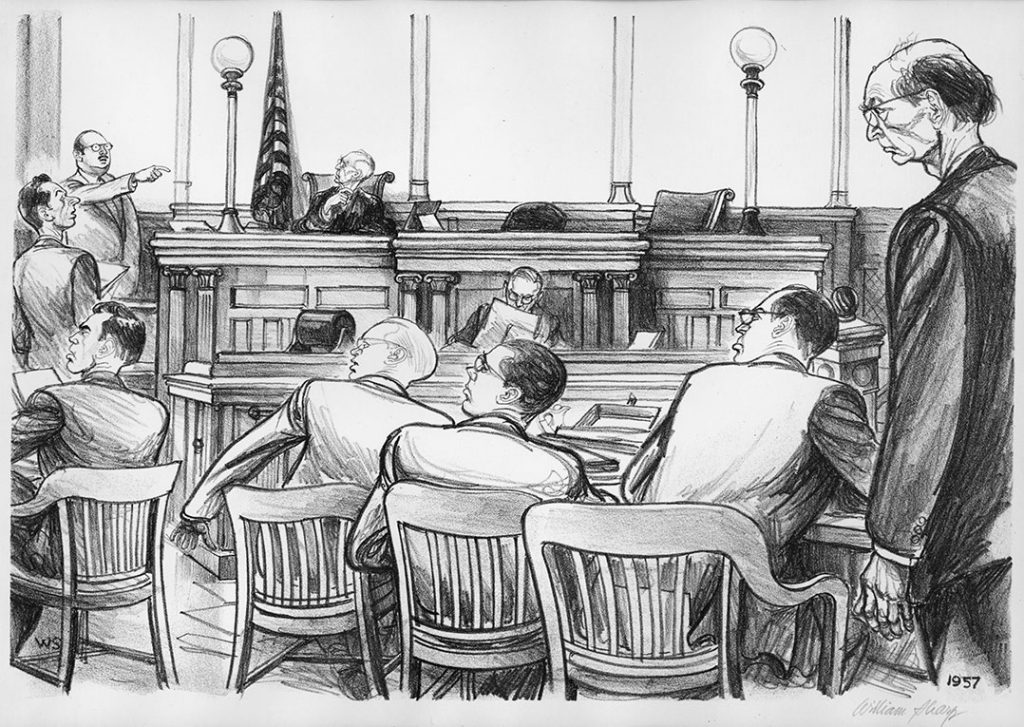
Nonetheless, the evidence against Abel was overwhelming. A search of his Manhattan hotel room and Brooklyn studio turned up short-wave radios, microfilm equipment, marked-up maps of major U.S. defense areas, a code book, coded messages, and hollowed-out objects (bolts, pencils, and cufflinks) that could contain such messages.
Inevitably, Donovan lost the case. But he worked with Abel to appeal the conviction, arguing all the way up to the Supreme Court that evidence used against Abel was seized in violation of the Fourth Amendment. Neither the Immigration and Naturalization Service (INS) nor the FBI had obtained a federal warrant to arrest Abel and search his rooms. Instead, INS agents, working with the FBI, had only a local administrative order granting them authority to detain Abel on a suspected immigration violation.
Donovan concluded his Supreme Court argument with a warning that resonates today, when fear of communists has been supplanted by fear of international terrorists.“Abel is an alien charged with the capital offense of Soviet espionage,” he wrote. “It may seem anomalous that our Constitutional guarantees protect such a man. … Yet our principles are engraved in the history and the law of the land. If the free world is not faithful to its own moral code, there remains no society for which others may hunger.”
In late March 1960, the Supreme Court upheld Abel’s conviction in a 5-4 decision.
Donovan filed a petition for a rehearing—not so much for Abel’s benefit, he wrote, as for “the millions of United States residents subject to the Immigration and Naturalization laws whose personal liberties were now ‘severely and unjustly curtailed by the decision in the Abel case.’”
The petition was denied, but Chief Justice Earl Warren paid Donovan an unusually high compliment. “I think I can say that in my time on this Court no man has undertaken a more arduous, more self-sacrificing task,” he said.
Fordham Law professor Thomas Lee said that although Donovan’s decision to defend Abel was “heroic,” it was not as iconoclastic as his argument before the Supreme Court.
“There was a large number of people then, as now, who believe that basic procedural rights should be given to anyone regardless of their ideology or the color of their skin,” said Lee, the Leitner Professor of International Law at Fordham and a former Navy intelligence officer. But Donovan’s appeal went further, putting him “in the iconoclastic camp, as a more thoughtful or forward-seeking person who acknowledged that we’re going to overreact in these times of emergencies, and we should stick up for these people.”
During the appeal process, Abel was in the U.S. Penitentiary in Atlanta, serving a 30-year sentence. He’d been convicted of conspiracy to commit military and atomic espionage, a crime punishable by death.
At his sentencing, on November 17, 1957, Donovan made another iconoclastic move. He successfully argued against the death penalty, enumerating five points, the last of which Lee described as “positively brilliant and prescient.”
“It is possible,” Donovan said in court, “that in the foreseeable future an American of equivalent rank will be captured by Soviet Russia or an ally; at such time an exchange of prisoners through diplomatic channels could be considered to be in the best national interests of the United States.”
The Negotiator in East Berlin: A “War of Nerves” with the KGB
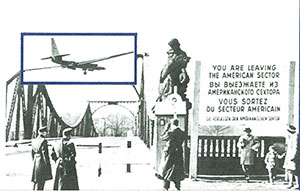
On May 1, 1960, Donovan’s hypothetical scenario came true: U.S. pilot Francis Gary Powers was captured in the Soviet Union, after his U-2 surveillance plane was shot down outside of Sverdlovsk, precipitating an international crisis and heightening fears that the Cold War could turn hot.
While working on the Abel case, Donovan had corresponded with a “Mrs. Hellen Abel,” allegedly the colonel’s wife but actually a KGB officer, and with Wolfgang Vogel, an East German lawyer who claimed to represent Abel’s family. Soon after Powers was captured, Oliver Powers, the pilot’s father, wrote to Abel, suggesting a swap. Abel advised Powers to take it up with Abel’s “family,” which he did. They came to Donovan.
With CIA and State Department approval, Donovan offered to meet Abel’s family representatives at the Soviet Embassy in East Berlin on February 3, 1962, soon after he was planning to be in London on business.
Before leaving, he met with the CIA’s assistant general counsel for a final briefing. They discussed two American college students detained on trumped-up espionage charges: Frederic L. Pryor, who was being held by the East Germans, and Marvin Makinen, who was in a Soviet prison in Kiev. “The government’s advice to me was that while I should try to release all three Americans,” Donovan wrote, “my basic mission would be to exchange Abel for Powers.”
There was one other detail: Once he crossed into East Berlin, he’d be on his own, with no official backing from the State Department or the CIA. In case anything went wrong, the government did not want to be publicly tied to the effort.
On February 2, after several days in London, Donovan sent a cablegram to his wife explaining that he’d be extending his trip, visiting friends in Scotland. Then he left for cold, snowy Berlin.
For the next eight days, he lived alone in a house outside West Berlin. He passed over the Berlin Wall—“a very real wall,” he said, “of barbed wire, machine guns”—by taking an S-Bahn train one stop into East Berlin. He’d last been there in 1945, working on The Nazi Plan. At the time, he wrote, the city “was demolished and barren, as though starkly sketched by Goya.” Nearly 17 years later, “East Berlin appeared to be unchanged.”
At the Soviet Embassy, he met several people purporting to be Abel’s relatives. Then Ivan Schischkin introduced himself as the second secretary of the embassy. As Donovan suspected, he was, in fact, a senior KGB officer. Donovan also met with Vogel, the East German lawyer who represented both Abel and Pryor.
In the evening, he’d go to the Berlin Hilton’s dimly lit Golden City Bar and write a summary of the day’s negotiations. His CIA contact would meet him there and relay Donovan’s reports to Washington.
The negotiations lasted several days—Donovan, suffering from a bad back, called them “a war of nerves.” When he suggested a three-for-one swap, Schischkin stalled, saying he’d never heard of Makinen and Pryor. Two days later, he said the Soviet government would trade only Powers or Makinen for Abel but not both. He suggested that Donovan deal with Vogel regarding Pryor.
At one point, Donovan threatened to call it all off and go home if the students were not included in the deal with Powers. It was a high-stakes move, but it ultimately paid off.
At 8:20 a.m. on February 10, Donovan walked toward the middle of the Glienicke Bridge, a disused suspension bridge over the Havel River, connecting West Berlin with the East German city of Potsdam. It was a discreet, metaphorically appropriate spot for a high-profile spy swap—a dividing line between East and West, and a hopeful symbol of how tensions and forces could be harnessed to link disconnected lands.
With Donovan were several people, including an American pilot who could identify Powers. Abel and a prison guard followed five paces behind them. Schischkin and others approached from the other side of the bridge, with Powers trailing them.
Meanwhile, about 20 miles away, at Checkpoint Charlie, Pryor was about to be released to his parents and a State Department official. Once Donovan received word that Pryor had been freed, he gave the signal for Abel and Powers to cross the centerline. Abel paused, Donovan wrote, “extended his hand to me and said, ‘Goodbye, Jim.’ I replied, ‘Good luck, Rudolf.’”It was the last he’d see of Abel, although he did hear from him again. Six months later, Abel sent Donovan two 16th-century, vellum-bound editions of the Commentaries on the Justinian Code.
Donovan had pulled off the swap. Powers and Pryor were free, and he’d left open negotiations for the return of Makinen, who was ultimately released in 1963.
Jan Donovan Amorosi was a student at Marymount University in Arlington, Virginia, when the historic swap became front-page news. “We had no idea where my father was,” she said. “In the early morning hours, a reporter called my mother in Brooklyn and congratulated her on what he’d done. She thought he was in Scotland playing golf!”
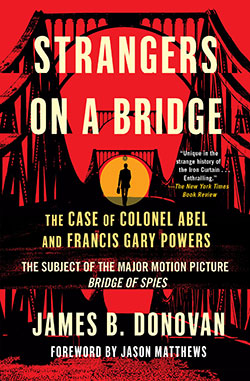
Donovan received numerous awards for his work on the exchange, including the CIA Distinguished Intelligence Medal and an honorary degree from Fordham. In 1964, his book, Strangers on a Bridge, became a bestseller. It was eventually translated into nine languages, including Braille, and—not surprisingly—almost became a movie.
“MGM bought the film rights, and Gregory Peck, who’d just won the Oscar for playing Atticus Finch in To Kill a Mockingbird, was very anxious to play my father,” said Mary Ellen Donovan Fuller, who met Peck in London, when she joined her father on a trip abroad.
Fuller said Peter Ustinov worked on a screenplay, and Alec Guinness was offered the role of Abel. “My father actually was a fan of Spencer Tracy—he loved Judgment at Nuremberg—so it was interesting to see Gregory Peck showing such enthusiasm, trying to make his mark with my father.”
Peck never got the chance due to MGM scheduling, Fuller said, but she and her siblings are thrilled that Tom Hanks is playing their father.
“To hear him talking about my father, I was flabbergasted. He was dead-on about who my father was as a man,” she said, “that he wasn’t just going to take on an assignment, he was planning to win.”
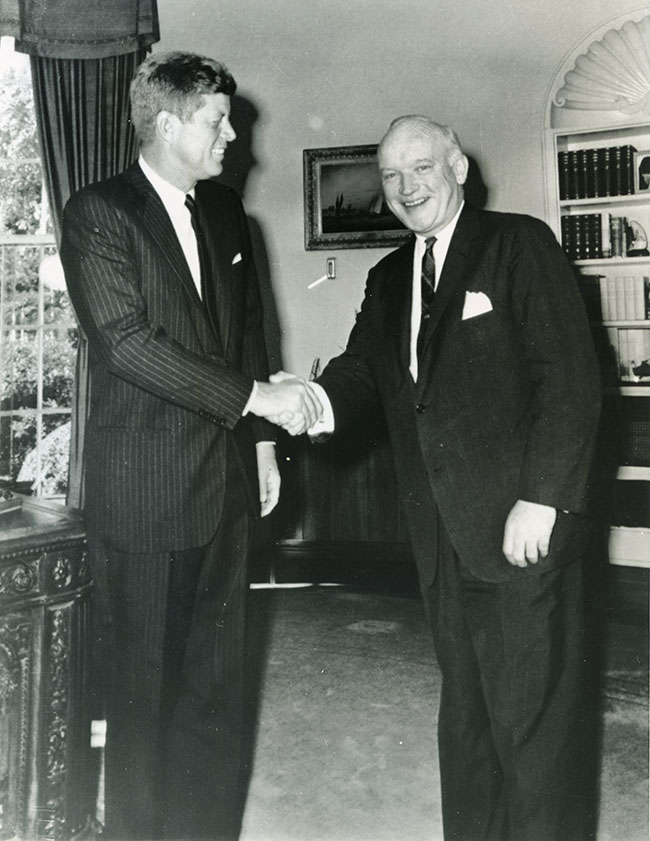
The Metadiplomat in Cuba: “A Man Who Knows How to Deal with Castro”
At the end of Bridge of Spies, Donovan returns home and goes almost immediately to bed. In reality, he had little time to rest. Several months after returning from Germany, he received another high-risk diplomatic assignment.
In June 1962, Attorney General Robert F. Kennedy met with representatives of the Cuban Families Committee for the Liberation of Prisoners of War. The group was struggling to raise funds to secure the release of 1,100-plus CIA-trained soldiers imprisoned in Cuba after the failed Bay of Pigs invasion. The April 1961 invasion, led by the CIA and authorized by President John F. Kennedy, was intended to oust the island’s communist leader, Fidel Castro. Instead, it heightened international tensions and marked a low point in U.S. foreign policy.
Robert Kennedy wanted to help the committee, but he couldn’t get the U.S. government directly involved in the negotiations. “What you need,” he advised the committee, “is a man who knows how to deal with Castro. … I think I know of a lawyer who might help.”
Donovan agreed to represent the Cuban Families Committee pro bono and, as usual, threw himself—heart, mind, and soul—into the effort, making multiple trips to Cuba in 1962 and 1963, before and after the Cuban Missile Crisis. He kept the attorney general and the CIA apprised of his efforts. And, in lengthy one-on-one negotiations, he managed to earn Castro’s trust, ultimately persuading the Cuban leader to accept an indemnity package consisting mostly of medicine and food.
The prisoners were released on Christmas Eve 1962. And Donovan returned to Cuba in April 1963, eventually securing the release of an additional 8,000-plus people, including relatives of the former prisoners and some U.S. citizens. On the spring trip, he brought along his son, John, who was 18 at the time.
“It was a psychological ploy,” John Donovan said, “a bit of gamesmanship. He knew that Castro himself had a son, so he took me along. He liked to do things as much as possible on a personal basis.”
As if he didn’t have enough on his plate, in September 1962 the New York Democratic Party nominated Donovan as its candidate for Senate. “To the despair of party workers,” The New York Times later wrote, he “campaigned like a man with more important things on his mind,” namely the Cuban prisoners. He ultimately lost to incumbent Jacob Javits.
Fordham alumnus Frank DeRosa, FCRH ’58, LAW ’61, was a young CIA lawyer at the time. He worked with Donovan on the mission to secure the prisoners’ release.
“I was just a raw kid out of Fordham Law,” said DeRosa, who’d passed the Foreign Service exam after college but was assigned to work for the CIA instead. “Donovan treated me like a prince, as if I had been in practice for 25 years.”
He spent several weekend days with Donovan in Brooklyn, visiting some of the older man’s favorite hangouts. At the Montauk Club in Park Slope, Donovan introduced DeRosa to friends such as John T. Connor and John E. McKeen, the heads of Merck and Pfizer, respectively. Both pharmaceutical companies made major donations of drugs to help secure the prisoners’ release.
“Donovan was a real hero to me, at an age when you still have heroes,” said DeRosa, who retired in the early 1990s as a group general counsel of General Electric. “He really made sacrifices—in time, pressure, stress.” DeRosa added that Donovan “made me a tough negotiator,” just by seeing “how he would go about it, the fact that he would take the moral high ground.”
During the 1960s, DeRosa conducted several oral-history interviews for the John F. Kennedy Presidential Library, talking with others who had worked with Donovan to bring home the Bay of Pigs prisoners.
“I think Donovan had the ability to get down to everybody’s level,” he said, noting that he was “steeped in Brooklyn Irish politics [and] brought a certain toughness and frankness” and sense of humor to conversations. “He could be a street fighter if he had to be, but he was also an educated bibliophile, a student of all things, including religion, and a fellow interested in helping the poor. He was a Renaissance man.”
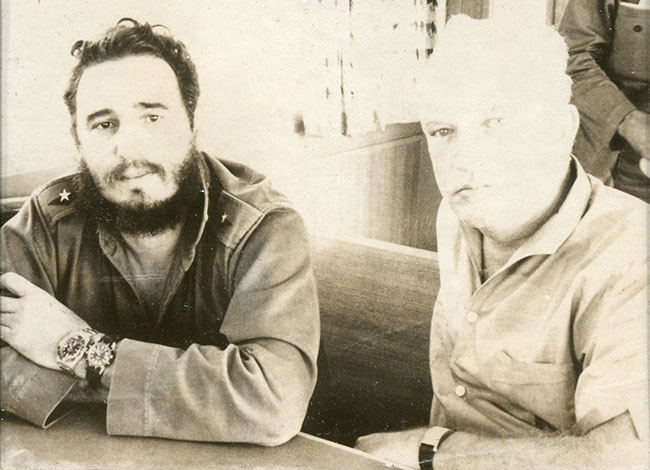
A Prayer for the Public Good: “Lord, Make Me an Instrument of Thy Peace”
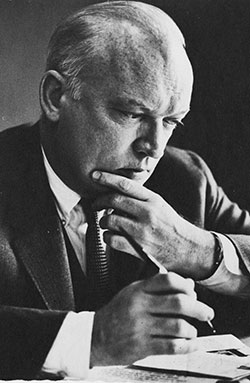
Following his success in Cuba and his failed Senate run, Donovan turned to challenges closer to home. He was elected president of the New York City Board of Education in 1963 and served in that role for two controversial years, when busing and the racial desegregation of schools were the hot-button issues. He maintained his law practice, and he found time to serve as the unpaid general counsel to the Jewish Nazi Victims Organization of America. He was named president of Pratt Institute in 1968, a time of student and faculty unrest. It was a position he held until January 19, 1970, when he died of a heart attack—one month shy of his 54th birthday.
“He liked challenges,” Jan Donovan Amorosi said of her father, “and he burned the candle at both ends. But he made amazing connections with people of all races and nationalities. One of my proudest moments was at his wake. There were black people kneeling at his casket, Cuban people, people of all races and creeds.”
On January 21, 1970, Robert I. Gannon, SJ, former president of Fordham, delivered a eulogy at St. Patrick’s Cathedral, calling Donovan “intelligent, fearless, and good—a man of principle” and “a family man.”
Mary Ellen Donovan Fuller said her dad “always took solace in the Jesuits at Fordham.”
“He’d periodically hang out in their Fordham digs and spar with some of them. That was a way of decompressing for him, because the Jesuits are known for their intelligence. It kept him motivated. The honor of doing good was almost a religious cause for him, and I think it was bolstered by his regular visits to campus.”
The summer before he died, Donovan also revisited Europe, Fuller said.
“My opinion is that he knew he was dying and, like an elephant going back to his grounds, he wanted to relive London again, the bookstalls, certain OSS drops in the churches over there. He went by himself to Nuremberg on that final trip, and it was a bit of closure for him after all those years.”
Donovan was buried in St. Agnes Cemetery in Lake Placid, where his tombstone bears the opening line of the Prayer of Saint Francis: Lord, make me an instrument of Thy peace.
“It was his favorite prayer, one that he actually read to Castro,” John Donovan said. “The next few lines go, ‘Where there is hatred, let me sow love; where there is injury, pardon; where there is doubt, faith,’ and so on.
“If you study the pattern of that prayer, you realize what my father understood: The best way to deal with negative things is not to try to eliminate the negative so much as to focus on the positive.”
